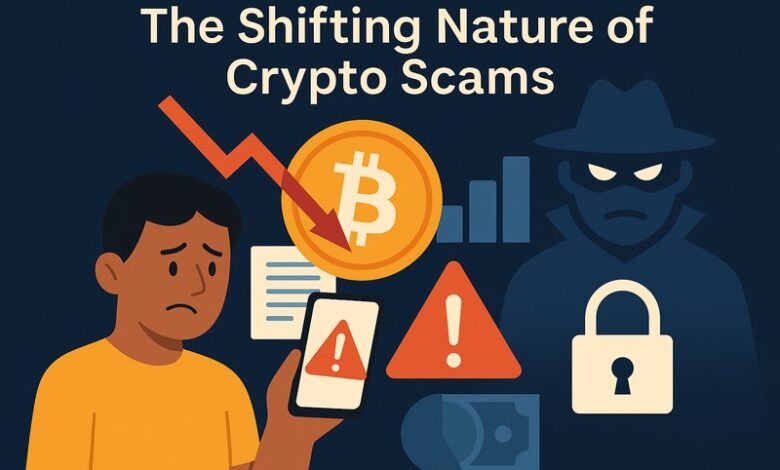The Evolving Landscape of Crypto Fraud in 2025: A Comprehensive Guide to Prevention, Forensics, and Recovery

Cryptocurrency, while offering innovation and autonomy, also presents increasingly complex threats in 2025, with global losses due to fraud now surpassing USD 12 billion annually, a 20% year-on-year increase.
Experts conservatively estimate the true scale to be at least double the official figures due to underreporting.
This isn’t just a law enforcement issue; it’s a public safety concern, a technological arms race, and a global challenge in behavioral economics. In fact, the digital asset space has become a mainstream financial environment, attracting sophisticated predators who leverage technology and human vulnerability.
The Shifting Nature of Crypto Scams
In 2025, crypto fraud has evolved from unsophisticated phishing links and fake ICOs to multinational fraud networks and technical attack vectors embedded in decentralized protocols.
Scammers now blend highly technical exploits, such as smart contract manipulation and cross-chain bridge attacks, with deeply human scams like fake romance and false recovery services. This “hybridisation of attack surfaces” makes current fraud insidious and resistant to traditional detection.
The success of these scams lies in their ability to bypass critical thinking and exploit human psychology, manipulating trust, urgency, and hope. Victims are often financially savvy professionals, small business owners, and even crypto enthusiasts who experience a “lapse in emotional security”.
Scammers use legitimate technologies for malicious purposes, employing automated trading bots, crafting false transparency with blockchain explorers, and deploying smart contracts that appear decentralized but grant single-actor control.
The widespread use of AI-generated content, including deepfake videos, cloned voice notes, and personalized phishing messages, has become the norm, making impersonation dangerously convincing. This marks a significant evolution: fraud is now data-driven and behavioral, personalizing scams at scale.
Scammers are highly adaptive, shifting tactics overnight in response to regulatory changes or takedowns. A striking trend is the rise of “fraud-as-a-service,” with subscription-based offerings on the dark web providing hosted scam websites, phishing kits, and even pre-written social media scripts. Many fraud operations are professionalized, run by full-time, salaried teams with dedicated personnel for technical deployment, social manipulation, and financial offboarding.
Understanding Major Crypto Scam Types
The sources break down several prevalent scam categories:
- Romance and Emotional Grooming Scams (“Pig Butchering”): These scams, often starting innocuously on dating apps or LinkedIn, build emotional rapport over time before subtly introducing fake investment opportunities. Victims are lured onto custom-built simulator platforms showing fake profits, and then encouraged to deposit more funds to “unlock” supposed gains or resolve fabricated issues. This works by building trust and then exploiting it.
- DeFi Scams (Rug Pulls, Flash Loan Attacks, Governance Manipulation): Decentralized Finance, while removing intermediaries, also removes accountability.
- Rug pulls occur when developers drain liquidity pools after promoting a token, leaving investors with worthless assets.
- Flash loan exploits leverage large uncollateralized loans to manipulate protocols.
- Governance attacks involve acquiring enough tokens to pass malicious code and seize funds. These scams thrive on complexity, as many victims are unfamiliar with smart contract mechanics.
- Investment Scams Disguised as Legitimate Platforms: These are fake exchanges or brokerages promising high, fixed returns, often operating as pseudo-Ponzi schemes where early investors are paid with later users’ funds. They mimic legitimate platforms to appear credible.
- Impersonation and AI-Enhanced Deception: Scammers use AI to clone voices and create deepfake videos of public figures or impersonate law firms and regulators to solicit payments or extract data. They trade on authority, making victims less likely to question requests.
- Fake Recovery Agents: A distressing trend where scammers target previous fraud victims, claiming to retrieve lost funds but only exploiting their desperation for additional fees or access to wallets. Often, the original fraudsters are behind these recovery pitches.
The Scam Lifecycle and Infrastructure
Scams operate like structured businesses, following a five-phase lifecycle:
1. Identification and Targeting: Scammers identify targets via scraped data or prior breaches, assigning them to specialized “handlers” who initiate contact through personalized messages, often on platforms like WhatsApp or Telegram.
2. Grooming and Trust Building: The longest phase, where fraudsters build trust through consistent, friendly communication, positioning themselves as helpful mentors or romantic partners. Small initial deposits with quick returns build confidence.
3. Escalation and Extraction: Once trust is established, pressure mounts to invest larger sums, with fake gains displayed on platform dashboards. Withdrawal attempts are met with delays or demands for more funds (e.g., “taxes,” “unlock fees”).
4. Exit and Obfuscation: The scam concludes, platforms shut down, and stolen funds are laundered by being split, bridged across chains, mixed through privacy tools, and routed through dozens of wallets before off-ramping.
5. Recycling and Retargeting: Victim data is recycled and sold, often leading to fake recovery service pitches.
Modern scams rely on sophisticated infrastructure, including fake platforms and apps that mirror legitimate ones and are often hosted on offshore servers. They use smart contracts with malicious backdoors that appear legitimate but contain hidden functions for draining or freezing funds. To cover tracks, fraudsters employ transaction obfuscation tools like mixers, privacy coins, and cross-chain bridges.
Victim behavior is key to understanding scams, as fraudsters exploit inherent human traits like trust bias, authority bias, sunk cost fallacy, social proof, and fear of missing out (FOMO).
Recognizing Red Flags and Prevention
Preventing fraud requires critical awareness and verification. Key red flags include:
- Promises of guaranteed or unrealistically high returns (e.g., 2% per day).
- Pressure to act quickly.
- Requests for private keys or seed phrases.
- Delayed or blocked withdrawals with excuses like KYC or tax issues.
- Impersonation of known entities using fake legal documents or slightly altered domain names.
- Suspicious smart contracts without audits or with “mint” and “burn” privileges.
- Recently created tokens or projects with no track record.
- Lack of regulatory or licensing information.
Practical preventative habits include: always verifying identities independently, never clicking unverified links, using reputable wallets and platforms, enabling multi-factor authentication (MFA), checking smart contract audits, and using read-only wallet connections or empty “burner” wallets for new DApps. Becoming familiar with block explorers (e.g., Etherscan) to track transactions is also crucial.
Blockchain Forensics and Legal Tools for Victims
When fraud occurs, blockchain forensics is crucial. Unlike cash, cryptocurrencies are traceable by design, with every transaction etched into an immutable ledger. Forensic investigators analyze transaction trails using block explorers, specialized forensic platforms (e.g., Chainalysis), smart contract analysis tools, and Open Source Intelligence (OSINT) to identify illicit activity, track asset movement, and attribute wallets to real-world identities. Timing is critical; the sooner forensic investigation begins, the higher the chance of tracing and freezing funds before they are fully laundered.
For victims, legal strategies begin with forensic evidence. Key legal tools include:
- Information Requests and Voluntary Disclosure to centralized exchanges that handled stolen funds, leveraging their compliance obligations.
- Asset Freeze Requests (Legal Hold Letters) sent to intermediaries like exchanges or stablecoin issuers to slow further transfers.
- Reporting to Regulatory and Law Enforcement Bodies to contribute intelligence, blacklist scams, and enable collective enforcement.
- Private Recovery Efforts and Negotiated Returns, sometimes facilitated through legal partners, can pressure fraudsters into partial restitution, especially when KYC details are exposed.
- Engaging with Stablecoin Issuers and Protocol Teams to block redemptions or freeze wallets.
- Preparing Comprehensive Victim Statements and Evidence Bundles to build a strong, consistent record for various channels.
Asset Recovery and Institutional Risk Management
Full recovery of stolen assets is rare (~5-10%), but partial recovery is common (~40-50%). Recovery depends on the timing of the report, use of centralized infrastructure, quality of forensic evidence, and jurisdictional reach. Even if funds aren’t fully returned, forensic evidence can lead to enforcement, regulatory action, and disruption of scam operations. Victims are encouraged to report, as shame or self-blame can deter action, but scams are engineered to be convincing, and the only mistake is silence.
Institutions are increasingly targeted for crypto fraud, including client onboarding fraud, vendor impersonation, and internal compromises. To manage this, risk management programs should focus on:
- Know Your Transaction (KYT): Real-time monitoring of wallet behavior and asset movements for suspicious patterns.
- Access and Wallet Control: Segregating wallet roles, multi-signature requirements, and regular revocation of smart contract approvals.
- Counterparty Risk Assessments: Vetting third-party partners like exchanges and DeFi platforms.
- Internal Awareness and Employee Training: Mandatory security training, phishing simulations, and appointing a Crypto Risk Officer.
- Incident Response Playbooks: Pre-defined plans for swift action when an incident occurs.
- Regulatory Obligations and Disclosure: Staying aware of evolving frameworks (e.g., MiCA, FATF) and reporting fraud.
Future Trends in Fraud and Prevention
Future trends indicate more sophisticated fraud, including:
- AI-Driven Personalised Fraud: Even more tailored deepfakes and cloned voices.
- Cross-Chain and Multi-Protocol Exploits: Leveraging interoperability to obscure tracing across different blockchains.
- Scam-as-a-Service Models: The continued professionalization and commoditization of fraud tools.
- Insider Threats and Internal Collusion: Employees assisting fraudulent activities.
- Decentralized Scam Platforms: DAOs and anonymous smart contracts that have no central point of shutdown.
- Regulatory Arbitrage and Offshore Laundering: Fraud operations moving to jurisdictions with weaker enforcement.
- Fragmented Recovery Ecosystem: A proliferation of unauthorized “recovery agents”.
The future of prevention relies on education as infrastructure, embedding user awareness directly into wallet interfaces, exchanges, and public campaigns.
Ultimately, fighting crypto fraud requires a collaborative path forward, involving individuals, platforms, institutions, legal professionals, and regulators working together to share intelligence, standardize processes, and foster a culture of vigilance rather than shame.
For more information on Blockchain Forensics and Legal Services firm, Crypto Legal, click here.





